- Get link
- X
- Other Apps
In this article, You will read Tropical Cyclone, favorable Conditions for Formation, Stages of Formation, Structure, and Characteristics of Tropical Cyclone for UPSC IAS.
A tropical cyclone is a weather phenomenon that is essentially a rapidly rotating storm system with characteristics such as a low-pressure center, strong winds and thunderstorms that produce heavy rain, among others.
Tropical Cyclones
Tropical cyclones are violent storms that originate over oceans in tropical areas and move over to the coastal areas bringing about large-scale destruction due to violent winds (squalls), very heavy rainfall (torrential rainfall), and storm surge.
They are irregular wind movements involving the closed circulation of air around a low-pressure center. This closed air circulation (whirling motion) is a result of rapid upward movement of the hot air which is subjected to Coriolis force. The low pressure at the center is responsible for the wind speeds.
Squall – a sudden violent gust of wind or localized storm, especially one bringing rain, snow, or sleet.
Torrent – a strong and fast-moving stream of water or other liquid.
- The cyclonic wind movements are anti-clockwise in the northern hemisphere and clockwise in the southern hemisphere (This is due to Coriolis force).
- The cyclones are often characterized by the existence of an anticyclone between two cyclones.
- Tropical cyclones occur around the equator at 5 ° – 30 °, but also have varying names depending upon where in the world they form.
- An average tropical cyclone can travel about 300 to 400 miles a day, or about 3,000 miles before it dies out.
Conditions Favorable for Tropical Cyclone Formation
- Large sea surface with a temperature higher than 27° C,
- Presence of the Coriolis force enough to create a cyclonic vortex,
- Small variations in the vertical wind speed,
- A pre-existing weak low-pressure area or low-level-cyclonic circulation,
- Upper divergence above the sea level system,
Good Source of Latent Heat
- Ocean waters having temperatures of 27° C or more is the source of moisture that feeds the storm. The condensation of moisture releases enough latent heat of condensation to drive the storm.
- The depth of warm water (26-27°C) should extend for 60-70 m from the surface of the ocean/sea, so that deep convection currents within the water do not churn and mix the cooler water below with the warmer water near the surface.
- The above condition occurs only in western tropical oceans because of warm ocean currents (easterly trade winds push ocean waters towards the west) that flow from the east towards the west forming a thick layer of water with temperatures greater than 27°C. This supplies enough moisture to the storm.
- The cold currents lower the surface temperatures of the eastern parts of the tropical oceans making them unfit for the breeding of cyclonic storms.
Coriolis Force (f)
- The Coriolis force is zero at the equator (no cyclones at the equator because of zero Coriolis Force) but it increases with latitude. Coriolis force at 5° latitude is significant enough to create a storm [cyclonic vortex].
- About 65 percent of cyclonic activity occurs between 10° and 20° latitude.
Low-level Disturbances
- Low-level disturbance (thunderstorms – they are the seeds of cyclones) in the form of easterly wave disturbances in the Inter-Tropical Convergence Zone (ITCZ) should pre-exist.
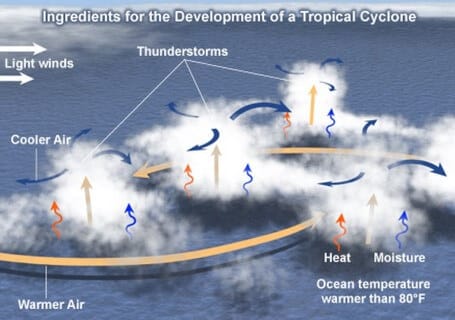
- Small local differences in the temperature of the water and of air produce various low-pressure centers of small size. A weak cyclonic circulation develops around these areas.
- Then, because of the rising warm humid air, a true cyclonic vortex may develop very rapidly. However, only a few of these disturbances develop into cyclones.
[rising of humid air => adiabatic lapse rate => fall in temperature of air => condensation of moisture in air => latent heat of condensation released => air gets more hot and lighter => air is further uplifted => more air comes in to fill the gap => new moisture available for condensation => latent heat of condensation and the cycle repeats]
Temperature contrast between air masses
- Trade winds from both hemispheres meet along the inter-tropical front. Temperature contrasts between these air masses must exist when the ITCZ is farthest, from the equator.
- Thus, the convergence of these air masses of different temperatures and the resulting instability are the prerequisites for the origin and growth of violent tropical storms.
Upper Air Disturbance
- The remains of an upper tropospheric cyclone from the Westerlies move deep into the tropical latitude regions. As divergence prevails on the eastern side of the troughs, a rising motion occurs; this leads to the development of thunderstorms.
- Further, these old abandoned troughs (remnants of temperate cyclones) usually have cold cores, suggesting that the environmental lapse rate is steeper and unstable below these troughs. Such instability encourages thunderstorms (child cyclones).
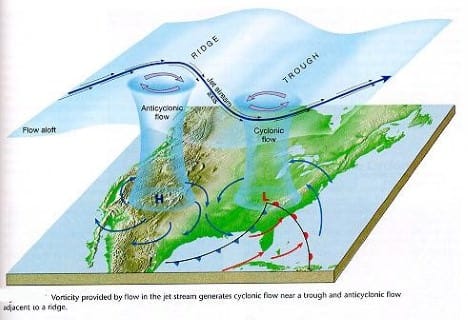
Wind Shear
- Wind Shear – differences between wind speeds at different heights.
- Tropical cyclones develop when the wind is uniform.
- Because of weak vertical wind shear, cyclone formation processes are limited to latitude equatorward of the subtropical jet stream.
- In the temperate regions, wind shear is high due to westerlies and this inhibits convective cyclone formation.
Upper Tropospheric Divergence
- A well – developed divergence in the upper layers of the atmosphere is necessary so that the rising air currents within the cyclone continue to be pumped out and a low pressure maintained at the center.
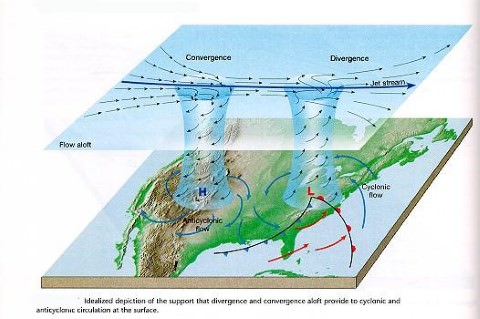
Humidity Factor
- High humidity (around 50 to 60 percent) is required in the mid-troposphere since the presence of moist air leads to the formation of cumulonimbus clouds.
- Such conditions exist over the equatorial doldrums, especially in western margins of oceans (this is because of the east to west movement of ocean currents), which have great moisture, carrying capacity because the trade winds continuously replace the saturated air.
Origin and Development of Tropical Cyclones
- The tropical cyclones have a thermal origin, and they develop over tropical seas during late summers (August to mid-November).
- At these locations, the strong local convectional currents acquire a whirling motion because of the Coriolis force.
- After developing, these cyclones advance till they find a weak spot in the trade wind belt.
Origin
- Under favorable conditions, multiple thunderstorms originate over the oceans. These thunderstorms merge and create an intense low pressure system (wind is warm and lighter).
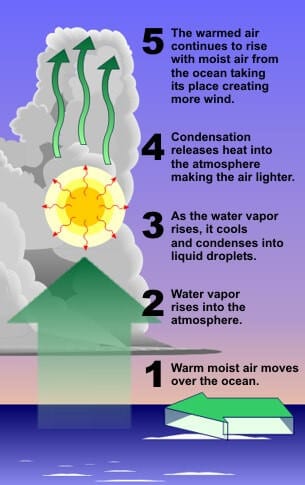
Early stage
- In the thunderstorm, the air is uplifted as it is warm and light. At a certain height, due to lapse rate and adiabatic lapse rate, the temperature of the air falls and moisture in the air undergoes condensation.
- Condensation releases latent heat of condensation making the air warmer. It becomes much lighter and is further uplifted.
- Space is filled with fresh moisture-laden air. Condensation occurs in this air and the cycle is repeated as long as the moisture is supplied.
- Due to excess moisture over oceans, the thunderstorm intensifies and sucks in the air at a much faster rate. The air from surroundings rushes in and undergoes deflection due to Coriolis force creating a cyclonic vortex (spiraling air column. Similar to a tornado).
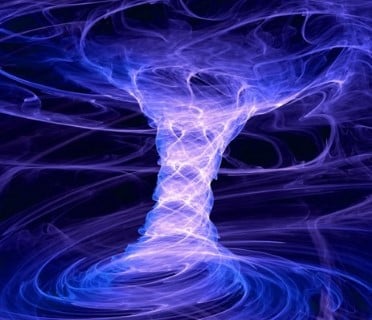
- Due to centripetal acceleration (centripetal force pulling towards the center is countered by an opposing force called the centrifugal force), the air in the vortex is forced to form a region of calmness called an eye at the center of the cyclone. The inner surface of the vortex forms the eyewall, the most violent region of the cyclone.
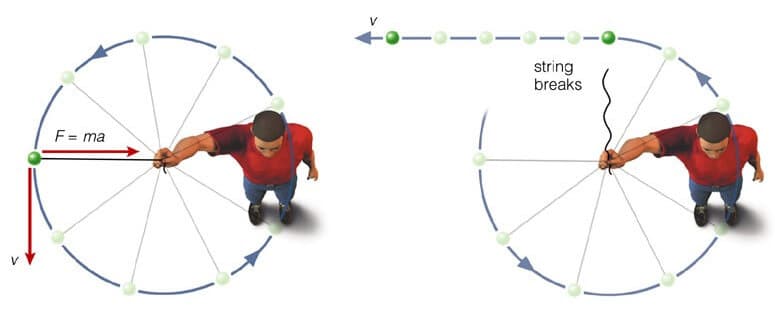
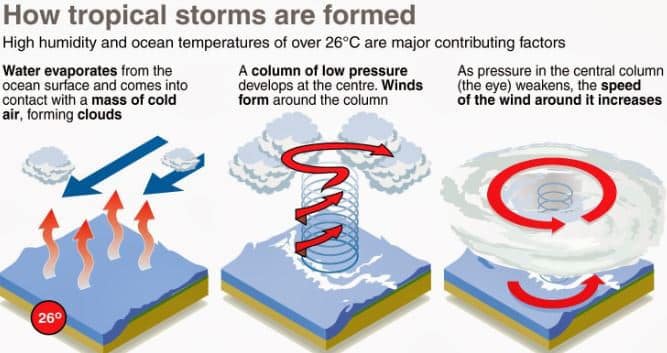
[Eye is created due to tangential force acting on wind that is following a curvy path]
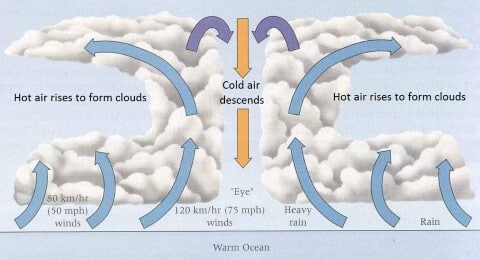
- All the wind that is carried upwards loses its moisture and becomes cold and dense. It descends to the surface through the cylindrical eye region and at the edges of the cyclone.
- Continuous supply of moisture from the sea is the major driving force behind every cyclone. On reaching the land the moisture supply is cut off and the storm dissipates.
- If ocean can supply more moisture, the storm will reach a mature stage.
Mature stage
- At this stage, the spiraling winds create multiple convective cells with successive calm and violent regions.
- The regions with cumulonimbus cloud (rising limbs of the convective cell) formation are called rain bands below which intense rainfall occurs.
- The ascending air will lose moisture at some point and descends (subsides) back to the surface through the calm regions (descending limbs of convection cell – subsiding air) that exist between two rain bands.
- Cloud formation is dense at the center. The cloud size decreases from center to periphery.
- Rain bands are mostly made up of cumulonimbus clouds. The ones at the periphery are made up of nimbostratus and cumulus clouds.
- The dense overcast at the upper levels of the troposphere is due to cirrus clouds which are mostly made up of hexagonal ice crystals.
- The dry air flowing along the central dense overcast descends at the periphery and the eye region.
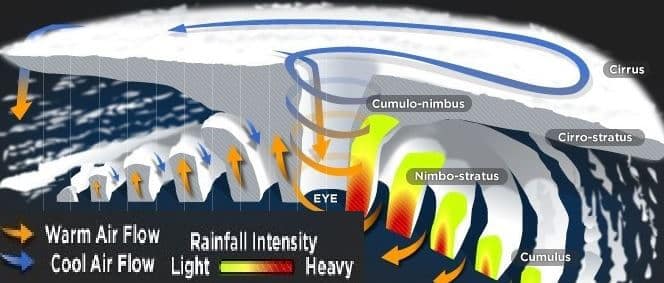
Structure of a tropical cyclone
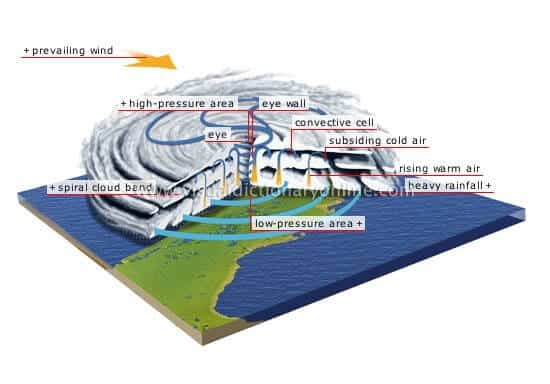
Eye
- A mature tropical cyclone is characterized by the strong spirally circulating wind around the centre which is called the eye.
- The “eye” is a roughly circular area of comparatively light winds, clear skies. and fair weather found at the center of a severe tropical cyclone.
- There is little or no precipitation and sometimes blue sky or stars can be seen.
- The eye is the region of lowest surface pressure and warmest temperatures aloft (in the upper levels) – the eye temperature may be 10°C warmer or more at an altitude of 12 km than the surrounding environment, but only 0-2°C warmer at the surface in the tropical cyclone.
- Eyes range in size from 8 km to over 200 km across, but most are approximately 30-60 km in diameter.
Eye wall
- The eye is surrounded by the “eyewall”, the roughly circular ring of deep convection, which is the area of highest surface winds in the tropical cyclone. The Eye Wall region also sees the maximum sustained winds i.e. fastest winds in a cyclone occur along the eyewall region.
- The eye is composed of air that is slowly sinking and the eyewall has a net upward flow as a result of many moderate – occasionally strong
- The eye’s warm temperatures are due to compressional warming (adiabatic) of the subsiding air.
- Most soundings taken within the eye show a low-level layer, which is relatively moist, with an inversion above – suggesting that the sinking in the eye typically does not reach the ocean surface, but instead only gets to around 1-3 km of the surface.
- The wind reaches maximum velocity in this region and torrential rain occurs here.
- From the eyewall, rain bands may radiate and trains of cumulus and cumulonimbus clouds may drift into the outer region.
Spiral bands
- Another feature of tropical cyclones that probably plays a role in forming and maintaining the eye is the eyewall convection.
- Convection in tropical cyclones is organized into long, narrow rain bands which are oriented in the same direction as the horizontal wind.
- Because these bands seem to spiral into the center of a tropical cyclone, they are called “spiral bands”.
- Along with these bands, low-level convergence is a maximum, and therefore, upper-level divergence is most pronounced above.
- A direct circulation develops in which warm, moist air converges at the surface, ascends through these bands, diverges aloft, and descends on both sides of the bands.
- Subsidence is distributed over a wide area on the outside of the rain band but is concentrated in the small inside area.
- As the air subsides, adiabatic warming takes place, and the air dries.
- Because subsidence is concentrated on the inside of the band, the adiabatic warming is stronger inward from the band causing a sharp contrast in pressure to fall across the band since warm air is lighter than cold air.
- Because the pressure falls on the inside, the tangential winds around the tropical cyclone increase due to the increased pressure gradient. Eventually, the band moves toward the center and encircles it, and the eye and eye wall form.
- Thus, the cloud-free eye may be due to a combination of dynamically forced centrifuging of mass out of the eye into the eyewall and to a forced descent caused by the moist convection of the eyewall.
Vertical Structure of a Tropical Cyclone
There are three divisions in the vertical structure of tropical cyclones.
- The lowest layer, extending up to 3 km and known as the inflow layer, is responsible for driving the storm.
- The middle layer, extending from 3 km to 7 km, is where the main cyclonic storm takes place.
- The outflow layer lies above 7 km. The maximum outflow is found at 12 km and above. The movement of air is anticyclonic in nature.
Categories of Tropical Cyclones
This is the tropical cyclone category system as used by the Bureau of Meteorology:
- Category one (tropical cyclone): A category one cyclone’s strongest winds are GALES with typical gusts over open flat land of 90-125kph,
- Category two (tropical cyclone): A category two cyclone’s strongest winds are DESTRUCTIVE winds with typical gusts over open flat land of 125-164kph,
- Category three (severe tropical cyclone): A category three cyclone’s strongest winds are VERY DESTRUCTIVE winds with typical gusts over open flat land of 165-224kph,
- Category four (severe tropical cyclone): A category four cyclone’s strongest winds are VERY DESTRUCTIVE winds with typical gusts over open flat land of 225-279kph,
- Category five (severe tropical cyclone): A category five cyclone’s strongest winds are VERY DESTRUCTIVE winds with typical gusts over open flat land of more than 280kph.
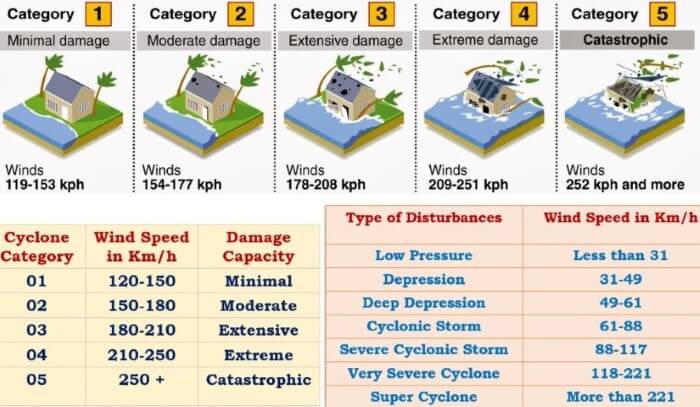
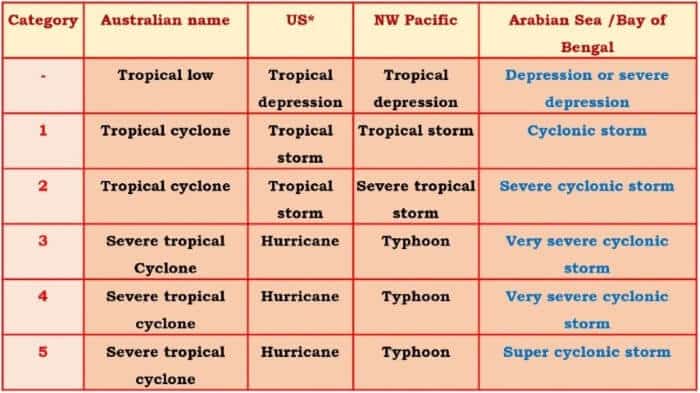
Favorite Breeding Grounds for Tropical Cyclones
- South-east Caribbean region where they are called hurricanes.
- Philippines islands, eastern China, and Japan where they are called typhoons.
- The Bay of Bengal and the Arabian Sea where they are called cyclones.
- Around the south-east African coast and Madagascar-Mauritius islands.
- North-west Australia.
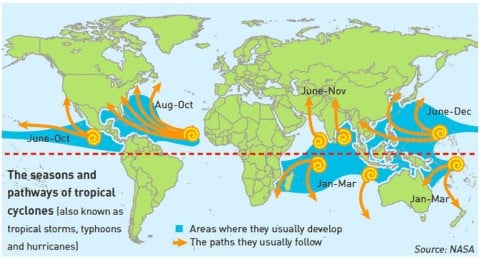
Regional names for Tropical Cyclones
| Regions | What they are called |
| Indian Ocean | Cyclones |
| Atlantic | Hurricanes |
| Western Pacific and South China Sea | Typhoons |
| Western Australia | Willy-willies |
Characteristics of Tropical Cyclones
The main features of tropical cyclones are as follows.
Size and Shape
- Tropical cyclones have symmetrical elliptical shapes (2:3 ratio of length and breadth) with steep pressure gradients. They have a compact size—80 km near center, which may develop up to 300 km to 1500 km.
Wind Velocity and Strength
- Wind velocity, in a tropical cyclone, is more in poleward margins than at center and is moreover oceans than over landmasses, which are scattered with physical barriers. The wind velocity may range from nil to 1200 km per hour.
Path of Tropical Cyclones
- These cyclones start with a westward movement but turn northwards around 20° latitude. They turn further north-eastwards around 25° latitude, and then eastwards around 30° latitude. They then lose energy and subside.
- Tropical cyclones follow a parabolic path, their axis being parallel to the isobars.
- Coriolis force or earth’s rotation, easterly and westerly winds influence the path of a tropical cyclone.
- Tropical cyclones die at 30° latitude because of cool ocean waters and increasing wind shear due to westerlies.
Warning of Tropical Cyclones
- Detection of any unusual phenomena in the weather leading to cyclones has three main parameters: fall in pressure, increase in wind velocity, and the direction and movement (track) of the storm.
- There is a network of weather stations monitoring pressure fall and wind velocities in all countries of the world, including the Arctic and Antarctic regions.
- The islands attain special significance in this as they facilitate monitoring of these developments.
- In India, there are detection radars along both coasts.
- Monitoring is also done by aircraft which carry a number of instruments including weather radar.
- Cyclone monitoring by satellites is done through very high-resolution radiometers, working in the visual and infra-red regions (for night view) of the spectrum to obtain an image of the cloud cover and its structure.
- Remote sensing by radars, aircraft, and satellites helps predict where exactly the cyclone is going to strike. It helps in taking advanced steps in the following areas:
- closing of ports and harbors,
- suspension of fishing activities,
- evacuation of the population,
- stocking of food and drinking water, and
- provision of shelter with sanitation facilities (safety homes).
- Today, it is possible to detect a cyclone right from its genesis in the high seas and follow its course, giving a warning at least 48 hours prior to a cyclone strike.
- However, the predictions of a storm course made only 12 hours in advance do not have a very high rate of precision.
Major Differences between Temperate Cyclone and Tropical Cyclone
| Tropical Cyclone | Temperate Cyclone |
| tropical cyclones, move from east to west. | These cyclones move from west to east |
| A tropical cyclone has an effect on a comparatively smaller area than a Temperate cyclone. | Temperate cyclone affect a much larger area |
| The velocity of wind in a tropical cyclone is much higher and it is more damaging. | The velocity of air is comparatively lower |
| Tropical Cyclone forms only on seas with temperature more than 26-27degree C and dissipate on reaching the land. | Temperate cyclones can be formed on both land and sea |
| A tropical cyclone doesn’t last for more than 7 days | Temperate cyclone can last for a duration of 15 to 20 days |
Tornado
A tornado is a violently rotating column of air that extends from a thunderstorm to the ground. It is a vortex of rapidly moving air. A tornado forms when changes in wind speed and direction create a horizontal spinning effect within a storm cell. This effect is then tipped vertically by rising air moving up through the thunderclouds.
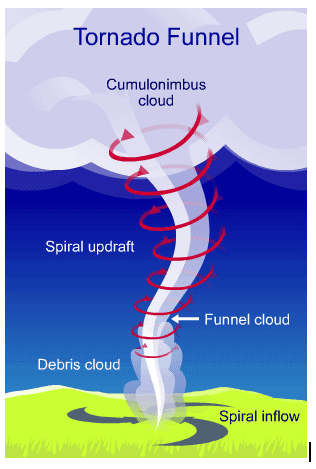
- Winds within the tornado funnel may exceed 500kmph.
- High-velocity winds cause most of the damage associated with these weather events.
- Tornadoes also cause damage through air pressure reductions.
- The air pressure at the tornado centre is approximately 800 millibars (average sea-level pressure is 1013 millibars) and many human-made structures collapse outward when subject to pressure drops of this magnitude.
Origin of Tornado
- Tornado formation typically needs four ingredients: shear, lift, instability, and moisture.
- Wind shear is the most important factor that plays into the creation of tornadoes. When there is wind shear, sometimes these winds begin to roll into a horizontal column of air.
- Once you get a strong updraft of air being transported from the ground to the atmosphere, that column of air becomes vertical. That is when a storm usually develops in this scenario.
- As the storm develops, it turns into a supercell thunderstorm much of the time. These supercell thunderstorms are separate, discrete cells that are not part of a line of storms. Also, supercells are storms that rotate and spin. With both the vertical, rotating column of air and the supercell thunderstorm together, that may bring down a tornado from the storm cloud
- Tornadoes are most common in spring and least common in winter. Spring and fall experience peaks of activity as those are the seasons when stronger winds, wind shear, and atmospheric instability are present. Tornado occurrence is highly dependent on the time of day, because of solar heating.
Distribution of tornadoes
- Rare in polar regions and infrequent at latitudes higher than 50° N and 50° S.
- The temperate and tropical regions are the most prone to thunderstorms.
- Tornadoes have been reported on all continents except Antarctica.
- The United States has the most violent tornadoes.
- Canada reports the second largest number of tornadoes.
- In the Indian sub-continent, Bangladesh is the most prone country to tornadoes.
- At any moment there are approximately 1,800 thunderstorms in progress throughout the world.
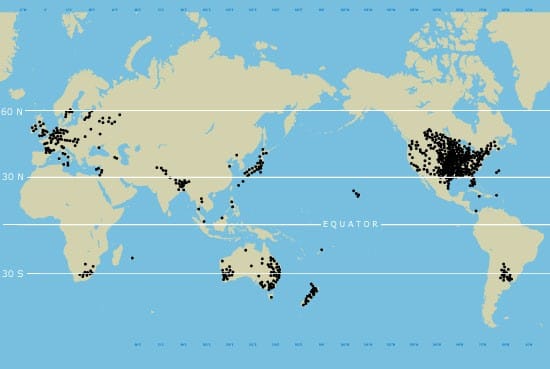
Differences between Tornado and cyclone
| Tornado | Cyclone | |
| Definition | A tornado is a rotating column of air ranging in width from a few yards to more than a mile and whirling at destructively high speeds, usually accompanied by a funnel-shaped downward extension of a cumulonimbus cloud. Winds 40-300+ mph. | A cyclone is an atmospheric system of rapidly circulating air massed about a low-pressure centre, usually accompanied by stormy often destructive weather. Storms that begin in the Southern Pacific are called cyclones |
| Rotation | Clockwise in the southern hemisphere and counter clockwise in the northern hemisphere | Clockwise in the southern hemisphere and counter clockwise in the northern hemisphere. |
| Forms of precipitation | rain | Rain, sleet, and hail |
| Frequency | The United States records about 1200 tornadoes per year, whereas the Netherlands records the highest number of tornadoes per area compared to other countries. Tornadoes occur commonly in spring and the fall season and are less common in winters | 10-14 per year |
| Location | Tornados have been spotted in all continents except Antarctica | Southern Pacific Ocean, Indian Ocean. Cyclones in the northwest Pacific that reach (exceed) 74 mph are “typhoons”. |
| Occurrence | Places where cold and warm fronts converge. Can be just almost anywhere. | warm areas |
Tornadoes, as well as cyclones both, occur in India. However, unlike cyclones, the frequency of tornado outbreaks is very low. Cyclones originate in the Bay of Bengal region as well as in the Arabian Sea region whereas Tornadoes of weak strength occur in the north-western and north-eastern region of the country causing significant damage to man and material.
Comments
Post a Comment